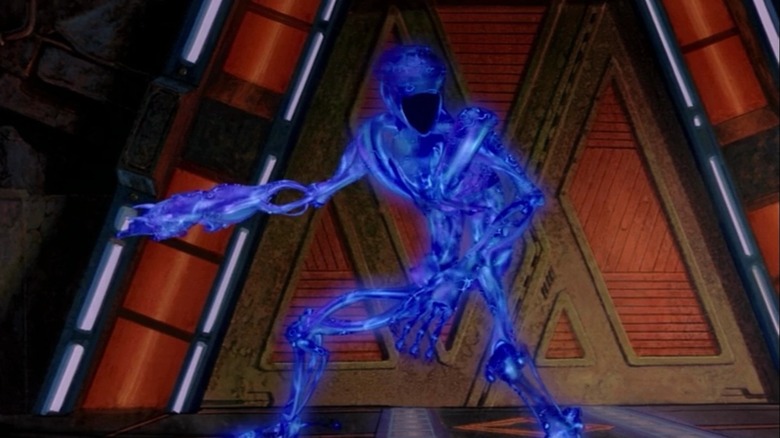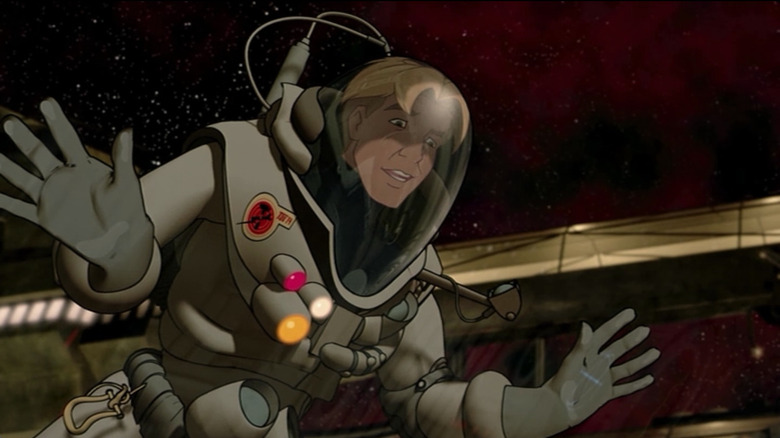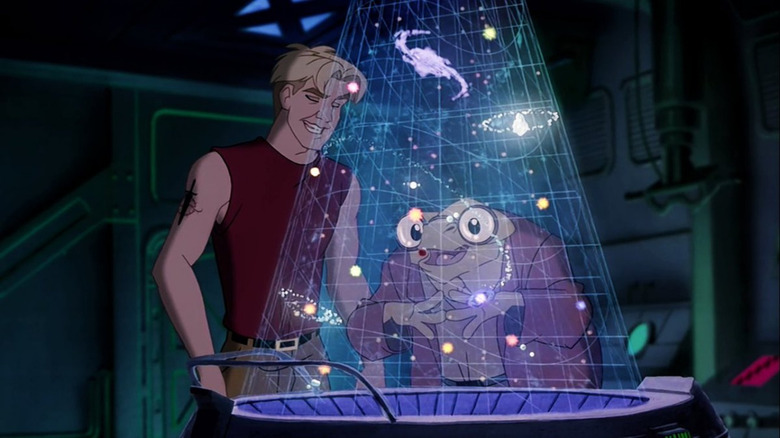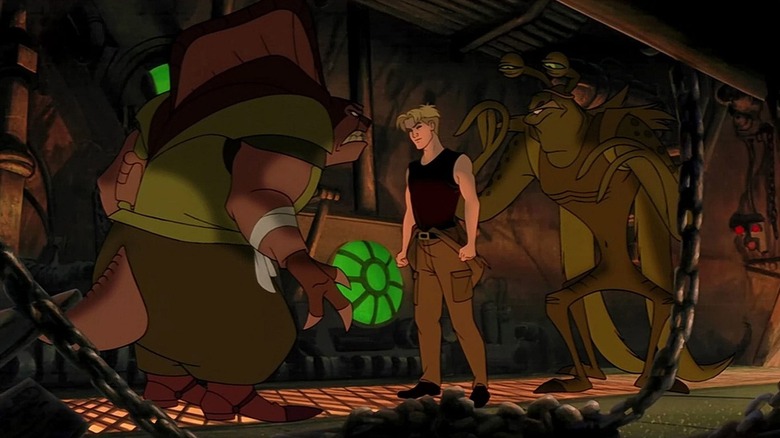Turmoil At Fox Animation Set Titan A.E. Up To Fail
The year is 3042, and the Earth has been destroyed. 15 years ago, humankind unveiled a mysterious and powerful technology called the Titan Project. Its true nature is not revealed immediately, but a species of envious aliens made of pure energy, the Drej, fear it and have destroyed humankind in defense. Now, the galaxy's remaining humans roam the cosmos as outcasts, forced to take odd jobs on freighters. A young human named Cale (Matt Damon) has taken a job on a vessel called the Valkyrie, where he works alongside a smarmy bat alien named Preedex (Nathan Lane), a kooky frog-like scientist named Gune (John Leguizamo), a bitter and angry kangaroo-like engineer named Stith (Janeanne Garofalo), a human pilot named Akima (Drew Barrymore), and the heroic Captain Korso (Bill Pullman). Together, they travel the stars avoiding Drej and following an obscure map to the location of the Titan, the ship that still contains Earth's technological breakthrough.
If it sounds like a very Joss Whedon-like setup, know that Whedon is one of the film's three credited screenwriters.
"Titan A.E." was an enormously ambitious animated project for directors Don Bluth and Gary Goldman. The video game "Space Ace" notwithstanding, Bluth had never worked on a sci-fi film before, and "Titan" was to be a slicker, hipper, more blockbuster-friendly film than some of the director's more family-friendly talking-animal films, "An American Tail" and "The Pebble and the Penguin."
"Titan A.E." was incredibly expensive for an animated film in 2000, costing a reported $75 million to make. Despite high energy, a fun story, and some striking visuals, the film tanked at the box office, earning only $36 million worldwide.
The production of "Titan A.E.," as a 2020 article in Polygon points out, was quite troubled.
Fox Animation in 2000
"Titan A.E." was released by 20th Century Fox on June 16, 2000. Fox Animation studios went defunct on June 26 of the same year. Fox Animation was not the production company that handled the studio's successful TV fare like "The Simpsons," but a film studio that attempted to break into feature films. Founded in 1994, the studio didn't put out its first film until 1997 when it released Don Bluth's "Anastasia." Thanks to an aggressive counter-programming measure by Disney — they re-released "The Little Mermaid" in theaters on the same day — "Anastasia" didn't make as much money as anyone hoped. Their only other completed production was "Titan A.E."
A brief aside: Fox Animation was variously working on several intriguing projects during its lifetime, including an adaptation of the book "Barlowe's Inferno," a "Rocky Horror"-like musical version of "Dracula," and a smutty send-up of Tarzan called "Betty of the Jungle." Fox Animation also initially had the rights to "Over the Hedge," a "Shrek"-like fairy tale spoof, and "Ice Age." Those films would eventually find homes elsewhere.
According to the Polygon article, Fox was already in financial dire straits when "Titan" was in production. Although "Anastasia" was a hit, it wasn't the blockbuster some hoped for, and by 1999, Fox Animation began slashing staff to the tune of 300 employees. To finish "Titan A.E.," production had to be abruptly outsourced to other studios, including Blue Sky, the recently-shuttered studio behind "Ice Age," "Robots," and "The Peanuts Movie." The small staff back at Fox caused production to slow to a crawl. Nothing seemed to be working right.
The expansion experiment
The 1990s were a great time for Disney's animation studio, and a multi-film run of hits throughout the first half of the decade is often referred to as the Disney Renaissance. Other animation studios leaped on the bandwagon, making notable Disney-like projects that were met with varying success. Films like "The Swan Princess," "FernGully: The Last Rainforest," "Balto," "The Pagemaster," and the enormous "Prince of Egypt" vied for a piece of the animation pie. Throughout, however, there was a notable lack of sci-fi and action films. Musicals and fairy tales were plentiful, but few animation studios tried to tap into the "boy's adventure novel" vibe of "Titan A.E."
As it so happens, such animated action films were roundly avoided in general. Not only did "Titan A.E." fail to attract massive audiences, but so too did Disney's 2001 Jules Verne knockoff "Atlantis: The Lost Empire," and their 2002 steampunk Robert Louis Stevenson riff "Treasure Planet." While these films were not violent or incredibly hard-edged — one might hear a "damn" — they still seem to have been victims of prejudice about animation, leading audiences to believe it was a medium for children and fairy tales. A sci-fi spaceship adventure simply wasn't going to work. Given how this year's "Lightyear" bombed, one might say the prejudice persists.
In an interview with Animation World in 2000, Goldman had faith that the change of pace would win people over, saying that his film was "not a 'mother friendly' movie. Although we haven't left the mothers and children out [...] There is some swearing, some sexual innuendo, it's intense ... there's a lot of violence. I don't think anybody under 8 years old should see this film."
That was a selling point many noped out with.
The teen boy market
Bluth has had a notoriously difficult time making money with his films. Although often quite original and possessed of excellent animation, audiences tend to stay away. He had hits with "An American Tail" and "All Dogs Go to Heaven," but films like "Rock-a-Doodle" and "A Troll in Central Park" simply didn't snag box office receipts. "Titan A.E." is Bluth and Goldman's last feature film to date, the pair having made only one music video and a few video games since.
The failure of "Titan A.E." is likely a combination of production woes (that increased its budget) and the above-mentioned aversion audiences carried for sci-fi in an animated medium.
Regardless of its lack of popularity and mixed critical response, "Titan A.E." is perfectly enjoyable space entertainment. It takes a lot of common space opera tropes and animates them to within an inch of their lives. Multiple sequences stand out, and a funny cast of talented voice actors makes the characters come to life. Although looking dated to modern eyes, the CGI-animated Drej were spindly and ineffable, looking truly alien. They were something that could not have been realized in live-action.
In 2022, it seems almost risible to imagine a sci-fi animated feature film. Indeed, most high-end sci-fi films in the modern era — "Star Wars," "Avatar," and "Avengers" — are largely animated with ultra-realistic textures and movements. If one can animate a photorealistic Na'Vi, then drawing one by hand almost feels quaint. "Titan A.E.," then, is a fascinating throwback, a relic of an era long since passed. It's certainly still worth discovering.



